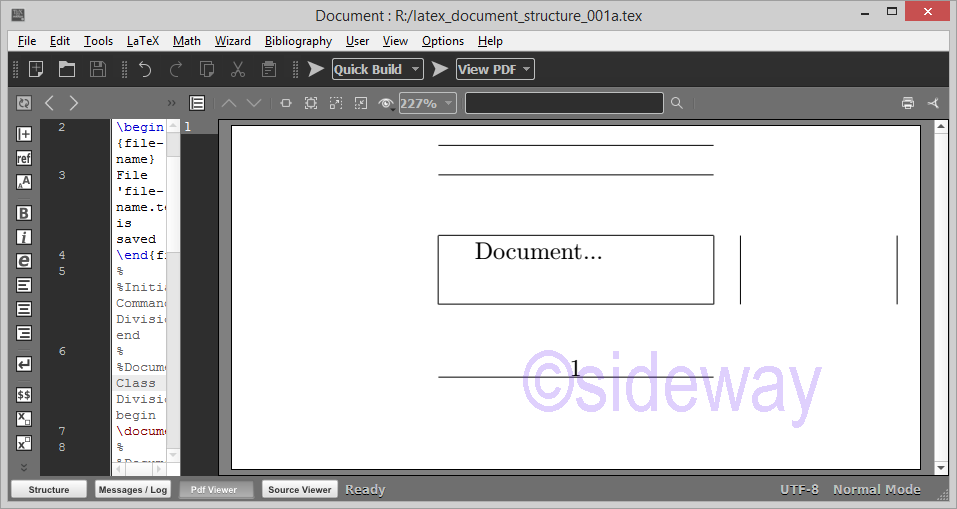LatexKnowledge Base
FeaturesFont TypesettingClass and PackagePropertiesStructureDocument SetupPage ElementsDocument Elements
Draft for Information Only
Content
LaTeX Typeset Document Structure
Example
Code
Output 'file-name.tex' File
Output
Initial commands
Document Class
Arguments
Options
Class
Optional Argument
Preamble Commands
\usepackage
Arguments
Option List
Package Name
Release Date
\listfiles
\setcounter
Document Environment
Ending
Source and Reference
LaTeX Typeset Document Structure
A LaTeX typeset document can be divided into divisions, namely, initial commands, document class, preamble commands, document environment, and ending.Example
Code
%%Initial Commands Division begin
\begin{filecontents}{file-name}
File 'file-name.tex' is saved
\end{filecontents}
%%Initial Commands Division end
%%Document Class Division begin
\documentclass{article}
%%Document Class Division end
%%Preamble Commands Division begin
\usepackage[papersize={100mm,50mm} , total={40mm,10mm},showframe]{geometry}
%%Preamble Commands Division end
%%Document Environment Division begin
\begin{document}
Document...
\end{document}
%%Document Environment Division end
%%End Division begin
Ending
%%End Division endOutput 'file-name.tex' File
%% LaTeX2e file `file-name'
%% generated by the `filecontents' environment
%% from source `latex_document_structure_001a' on 2022/02/22.
%%
File 'file-name.tex' is saved
Output

Initial commands
Initial commands can only be placed before the\begin{filecontents}{⟨file-name⟩}
⟨file-contents⟩
\end{filecontents}
The Document Class
LaTeX document class is actually a special preamble command which is used to define the fundamental properties of typeset document. The LaTex command used to specify the document class of a typeset document is\documentclass [⟨option-list⟩]{⟨class-name⟩}[⟨release-date⟩]
Arguments
Options
TheClass
TheOptional Argument
The optional argumentPreamble Commands
Preamble commands are commands that should only be used before\usepackage
Since standard document class cannot always solve all typesetting problems. One common way is to load one or several package to enhance the capabilities of LaTeX for providing new facilities. The command used to load package is\usepackage [⟨option-list⟩]{⟨package-name⟩}[⟨release-date⟩]
Arguments
Option List
ThePackage Name
Each package file as denoted byRelease Date
\listfiles
If\setcounter
The syntax ofDocument Environment
Document environment is used to place the text and document structure of the document. Document environment is enclosed between two commands\begin{document}
...
\end{document}
Ending
Ending is the division after theSource and Reference
- https://texfaq.org/FAQ-clsvpkg
- https://ctan.org/topic/class
- https://www.latex-project.org/help/documentation/usrguide.pdf
- https://ctan.math.illinois.edu/macros/latex/contrib/filecontents/filecontents.pdf
- https://www.math.hkbu.edu.hk/TeX/usrguide.pdf
- http://www.chiark.greenend.org.uk/doc/texlive-doc/latex/base/usrguide.pdf
- http://tex.loria.fr/ctan-doc/macros/latex/doc/html/usrguide/node15.html
©sideway
ID: 200501502 Last Updated: 2/22/2022 Revision: 1
Latest Updated Links
- Panasonic SR-CK05 RiceCooker CW-HZ70AA(last updated On 11/17/2025)
- Panasonic Hood Structure Ventilating Fan Blade Diameter: 8in FV-20WH307 CW-HZ70AA(last updated On 11/16/2025)
- Panasonic Window Mount Thermo Ventilator FV-30BW2H CW-HZ70AA(last updated On 11/15/2025)
- Panasonic Inverter PRO Inverter Window Heatpump Air-Conditioner (3/4 HP) CW-HZ70AA(last updated On 11/14/2025)
- Panasonic Inverter Window-Split Type Cooling Only Air-Conditioner (1 HP) CS-U9YWA(last updated On 11/13/2025)
- Panasonic Inverter Steam and Grill_Microwave Oven 27L NN_DS59NB(last updated On 11/12/2025)
- Panasonic KY-C223B Induction Cooker(last updated On 11/11/2025)
- Focus M41 Single lever kitchen mixer 160(last updated On 11/10/2025)
- Focus Single lever basin mixer 230(last updated On 11/9/2025)
- Precision Start Thermostat shower mixer(last updated On 11/8/2025)
- Tempesta 100 Shower Rail Set 3 sprays(last updated On 11/7/2025)

 Nu Html Checker
Nu Html Checker  53
53  na
na  na
na
Home 5
Business
Management
HBR 3
Information
Recreation
Hobbies 8
Culture
Chinese 1097
English 339
Travel 18
Reference 79
Hardware 40
Computer
Hardware 259
Software
Application 213
Digitization 37
Latex 52
Manim 205
KB 1
Numeric 19
Programming
Web 289
Unicode 504
HTML 66
CSS 65
SVG 46
ASP.NET 270
OS 431
DeskTop 7
Python 72
Knowledge
Mathematics
Formulas 8
Set 1
Logic 1
Algebra 84
Number Theory 206
Trigonometry 31
Geometry 34
Calculus 67
Engineering
Tables 8
Mechanical
Rigid Bodies
Statics 92
Dynamics 37
Fluid 5
Control
Acoustics 19
Natural Sciences
Matter 1
Electric 27
Biology 1
